BoreDoc supports you in professionally documenting drillings and maintaining an overview at all times. From recording the strata to the complete drilling log, BoreDoc bundles all important information in one place. This turns complex data into clear structures that are convincing both in everyday life on the construction site and when working with clients, authorities or partners.
BoreDoc is a cross-platform app for structured drilling documentation. It replaces handwritten forms and reduces errors through guided, structured input. Different project types such as soil sampling, exploratory drilling or well construction are supported - including the simple creation of layer directories, drilling profiles and other documents.
In contrast to traditional applications, BoreDoc works flexibly as an app and web application. Multiple users can work with the current database at the same time - regardless of end device or operating system. Integrated multilingualism makes collaboration even easier: if an English-speaking user enters "Clay", a German-speaking user automatically sees "Ton". Language settings in the user interface and in the documents can be freely selected.
BoreDoc thus optimises teamwork - in a structured, efficient and even cross-language manner. Whether for engineering offices, construction companies or experts: BoreDoc makes drilling documentation efficient, transparent and reliable.
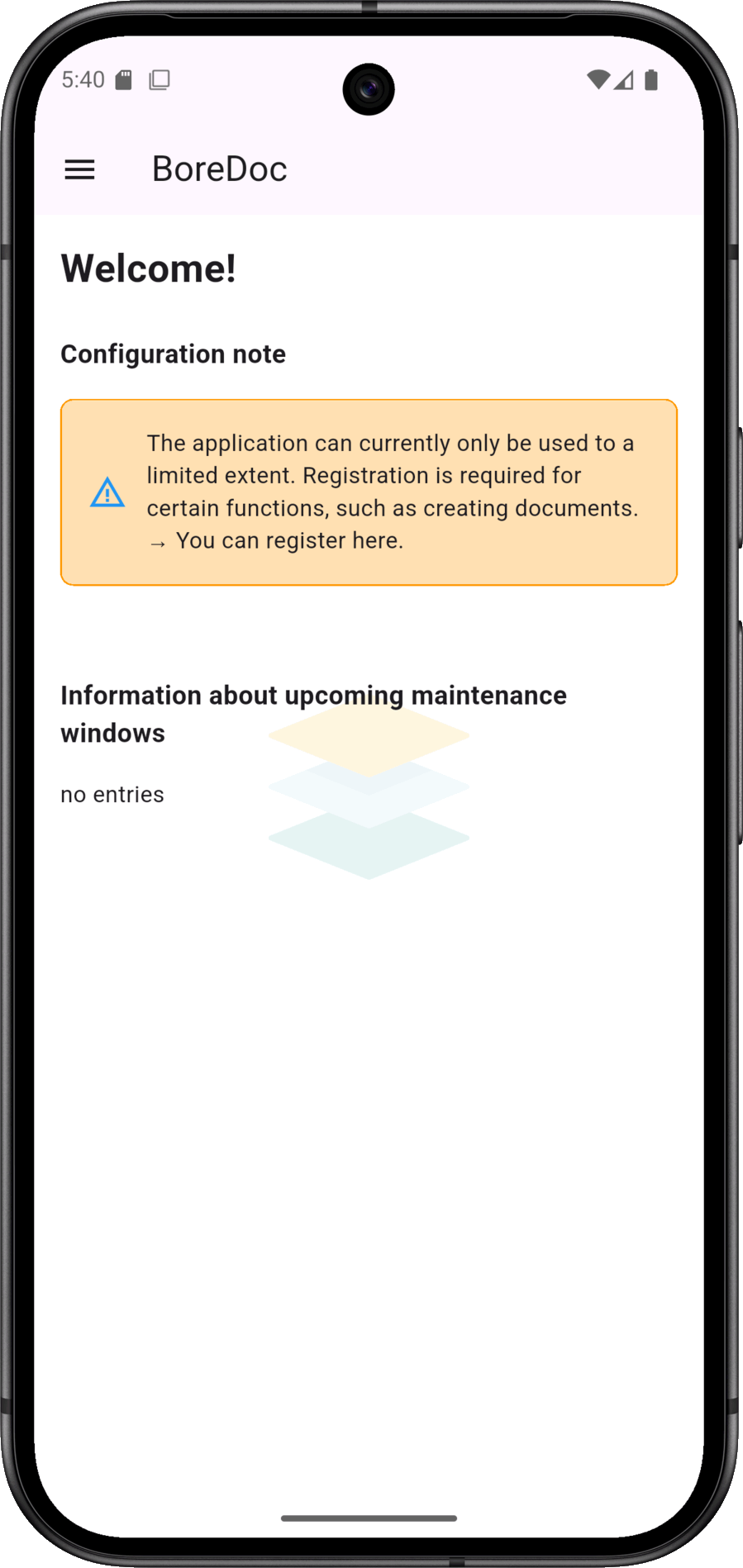
... The first step should be to register or transfer an existing registration. This is essential for creating documents.
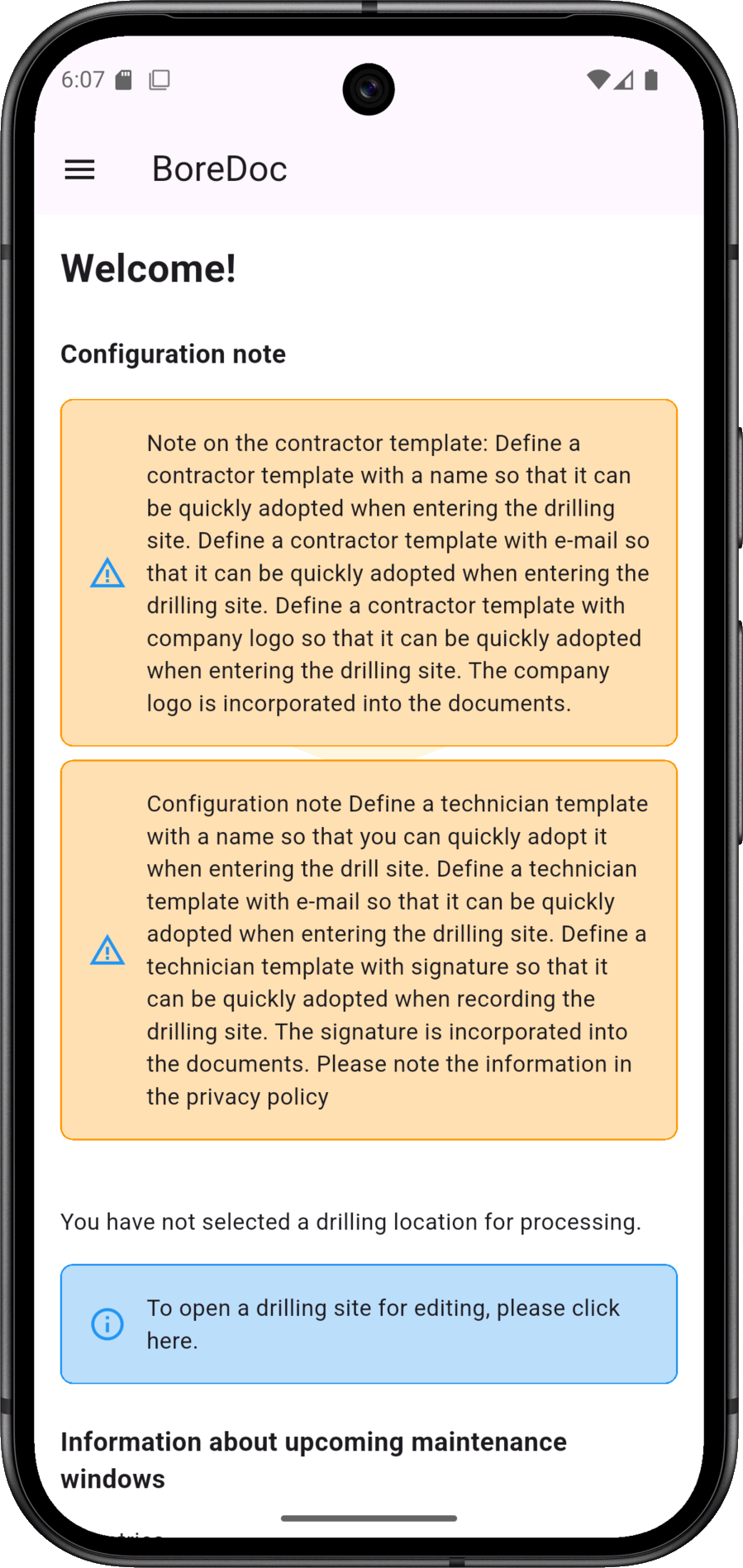
Completed templates for contractors and technicians speed up the entry of repetitive information in the input process. If the templates are not filled in, a message is displayed on the start screen.
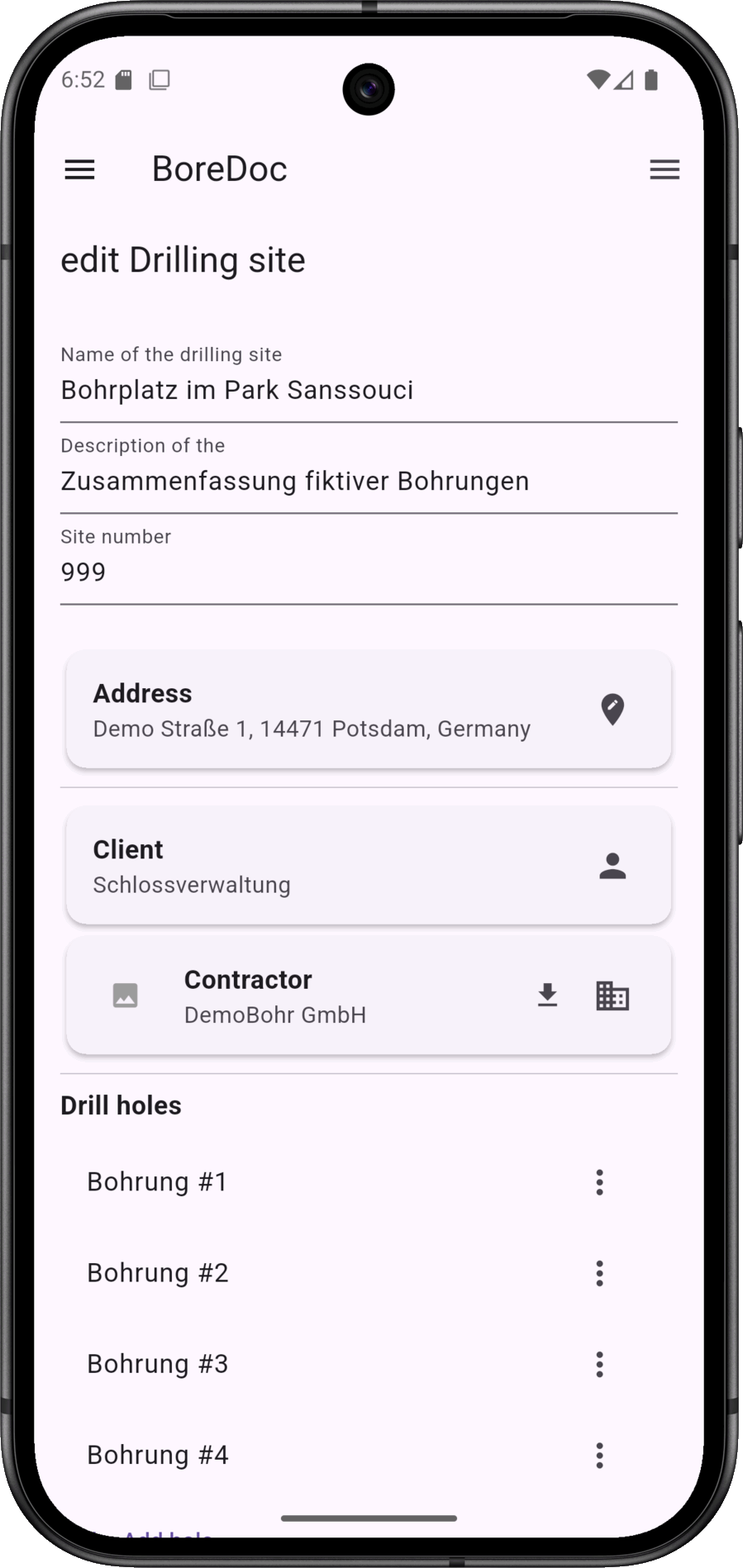
A drilling site includes master data, such as client and contractor, as well as several boreholes.
The context menu (sandwich icon top right) for the drilling site is also located here.
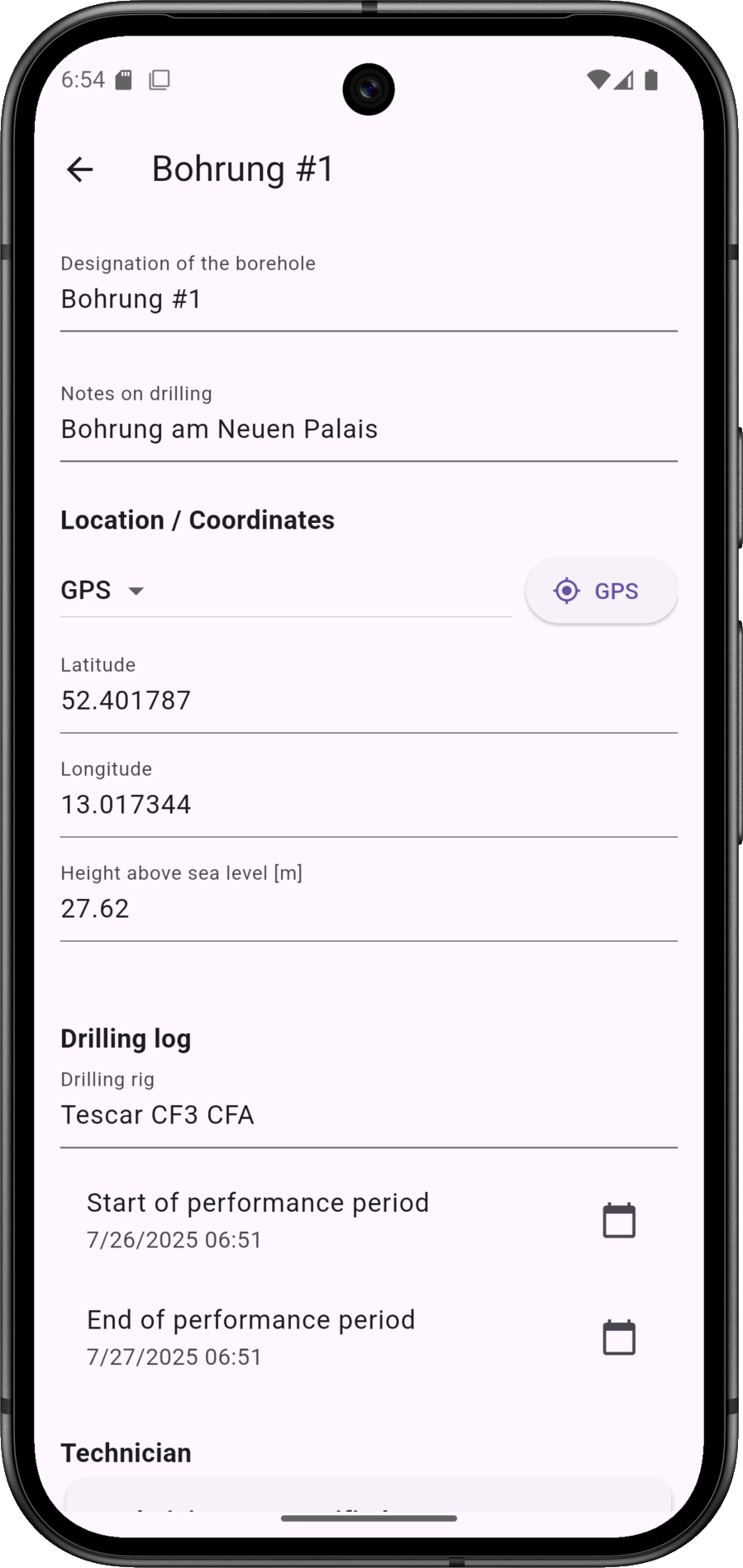
A borehole includes the usual data, such as name/designation, geo-coordinates, drilling protocol (execution period, technician, drilling sections, equipment used).
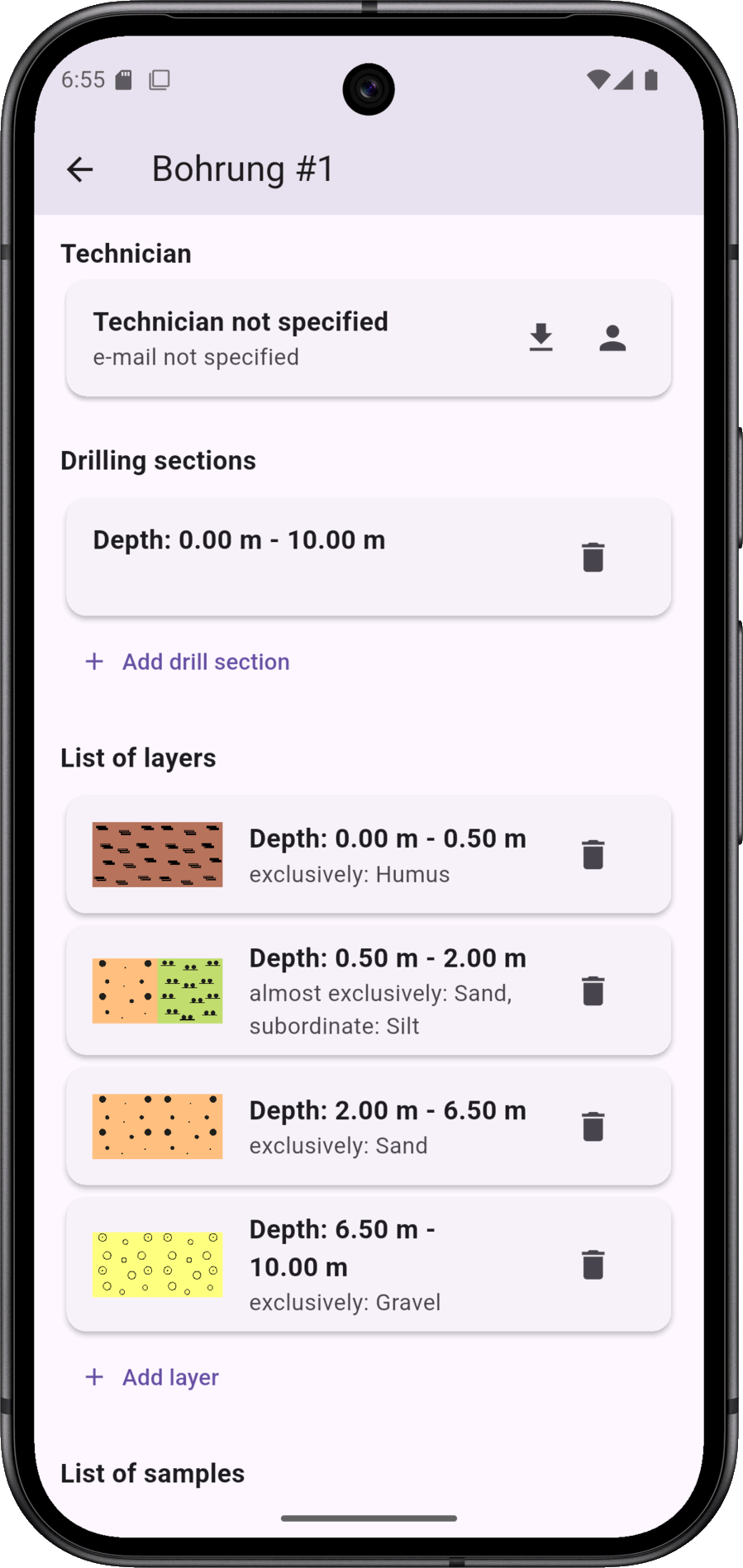
In addition, the borehole can be labelled with information on the soil layers, soil samples, water levels, backfilling and the development. Not all information is mandatory.
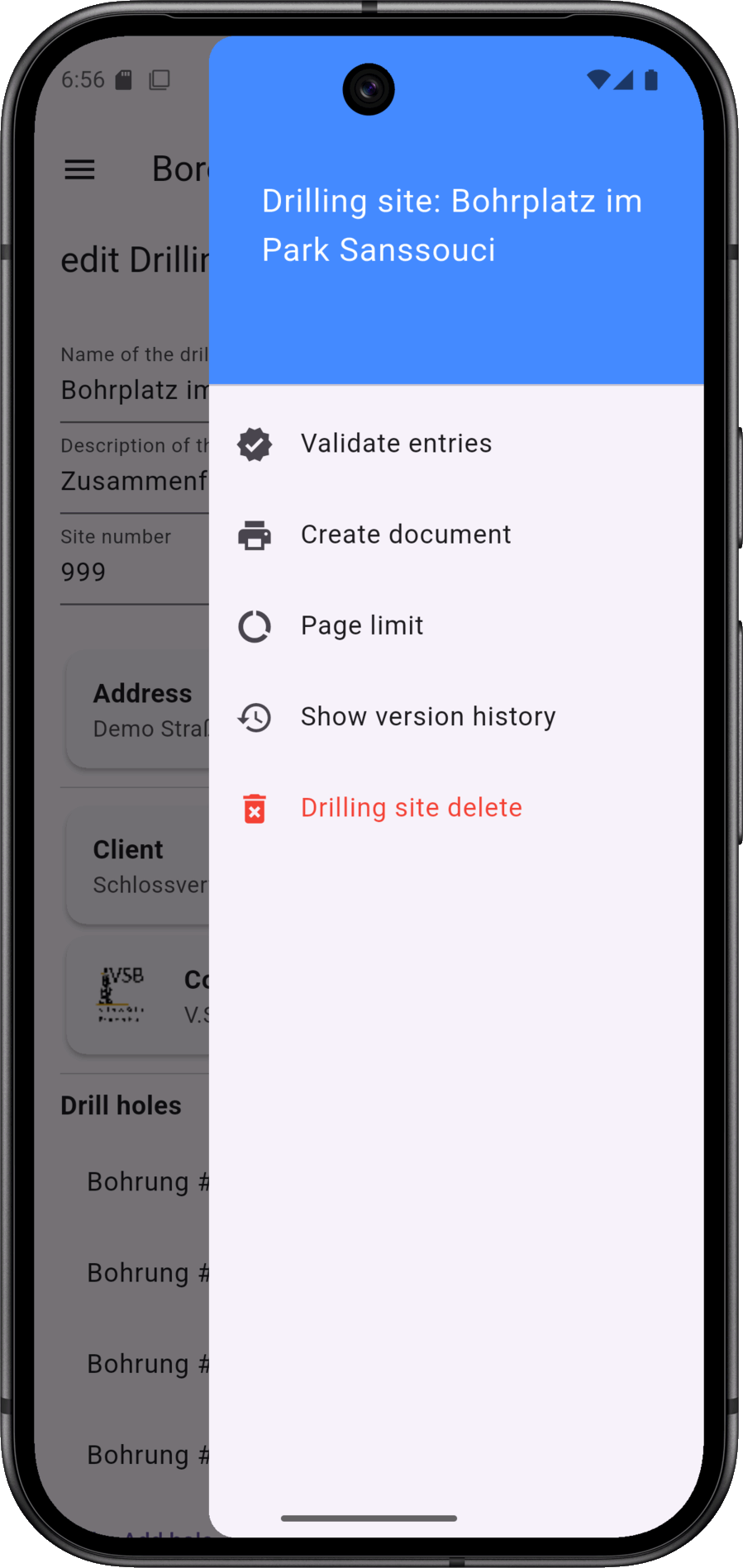
The context menu for the drilling site contains various functions, such as validating the entered data and triggering document generation.
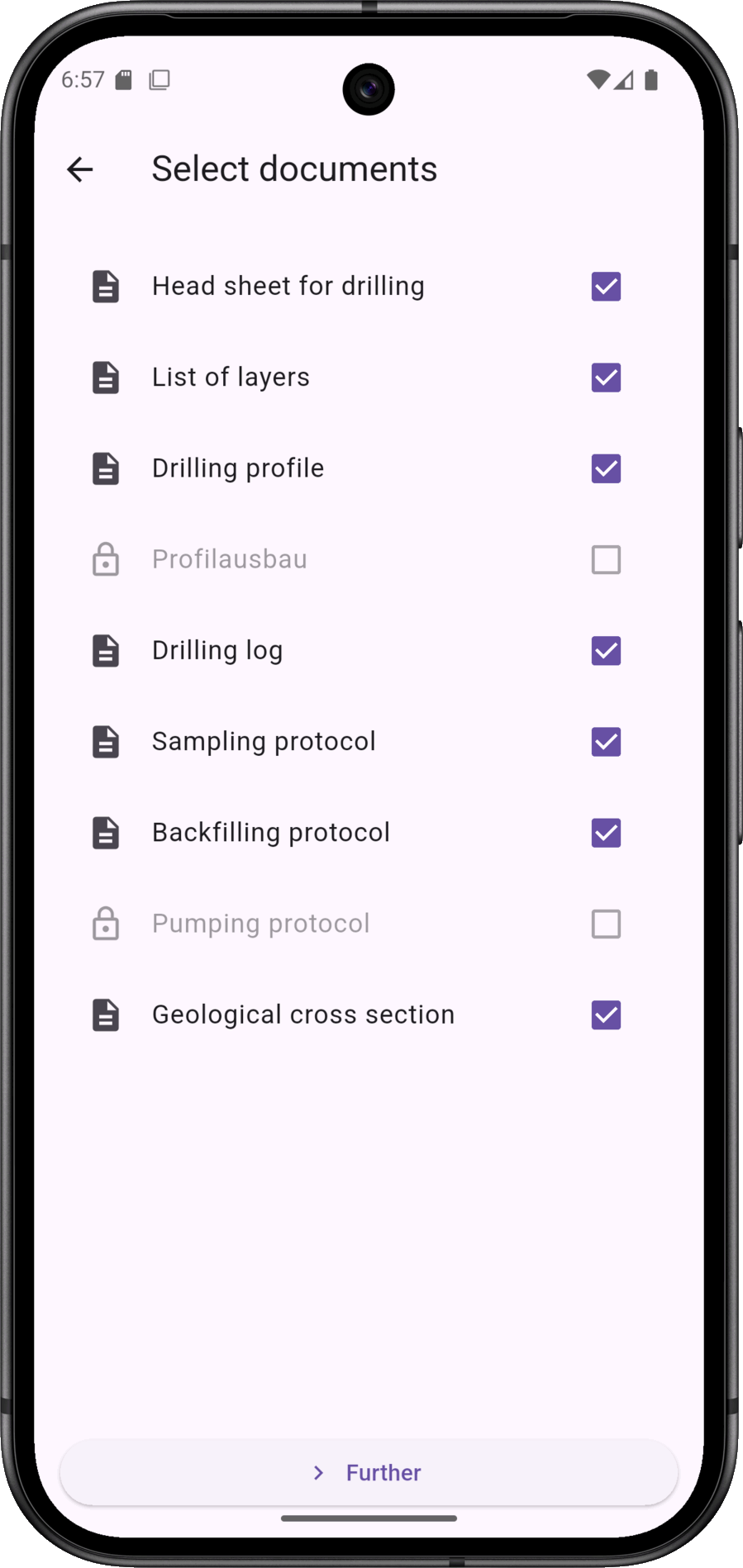
In the first step of validation, the documents to be generated are selected. These include the following: Stratigraphic log, drilling profile, drilling log, sampling log, geological section and others.
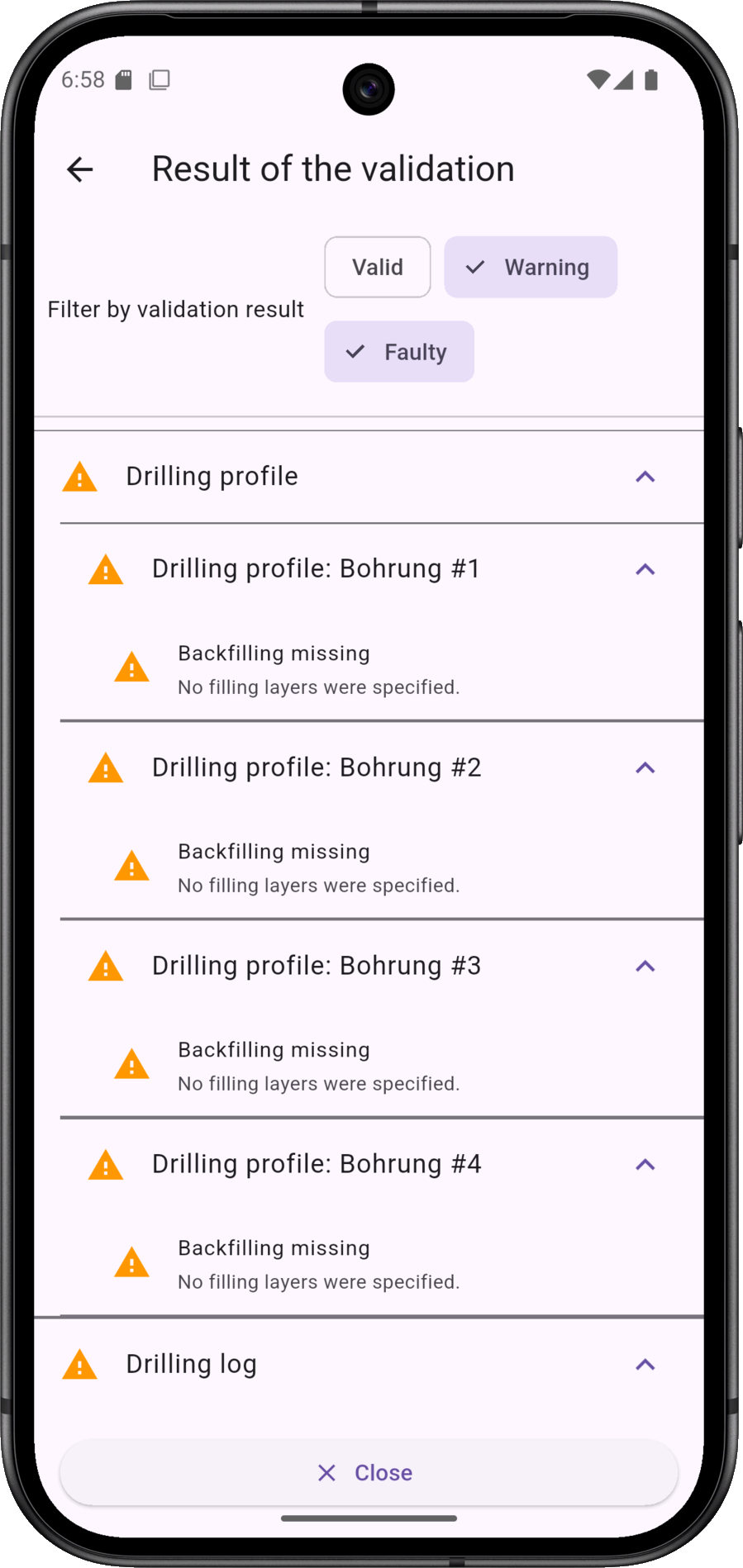
The validation result distinguishes between errors, warnings and valid. Warnings can be understood as hints. For example, it is not possible to create the extension of the borehole in the drilling profile if no information on the backfill has been provided.
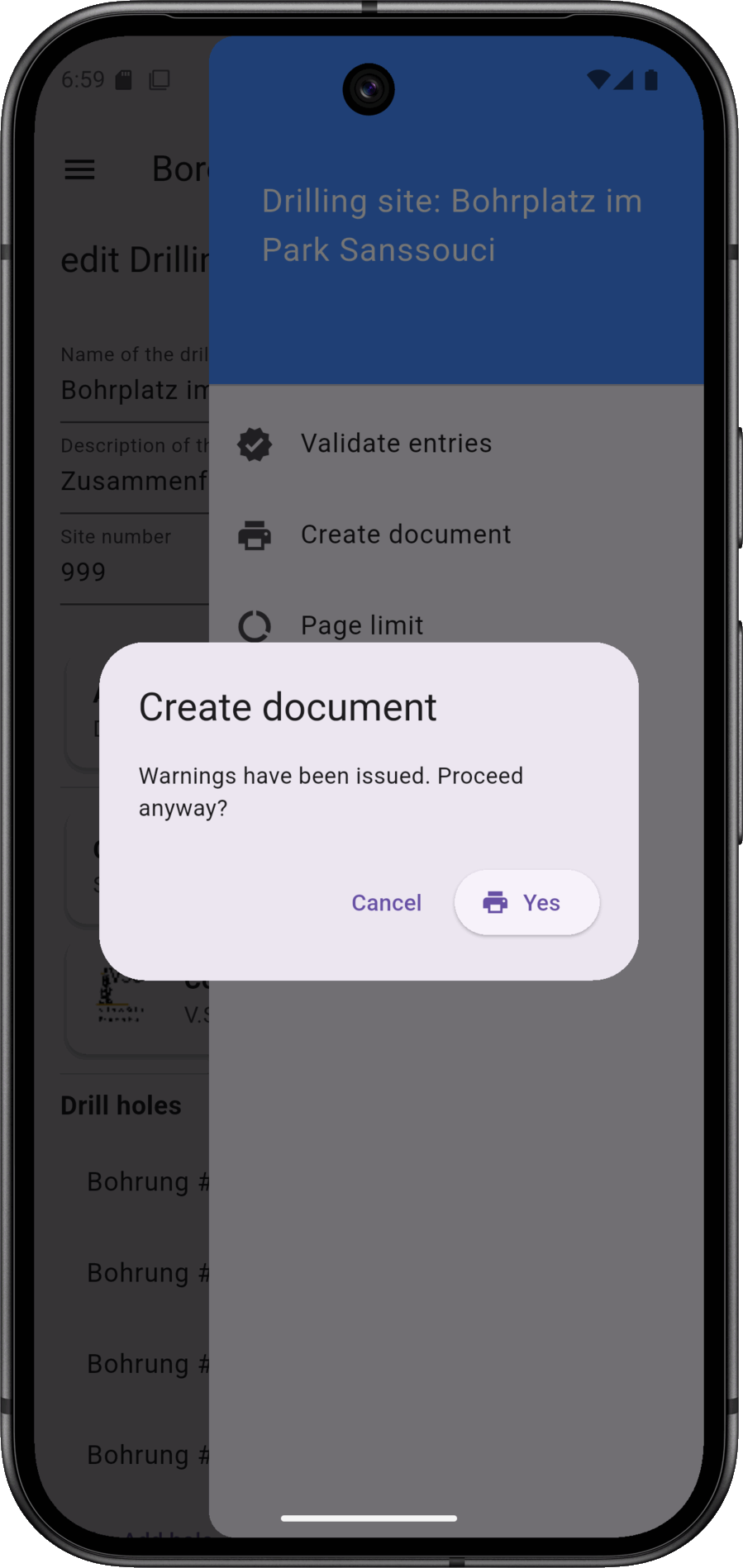
This function is available online
By requesting a document, the data from the drilling site is sent to the server and the documents are generated there. Depending on the connection speed, the process takes 5 to 20 seconds.
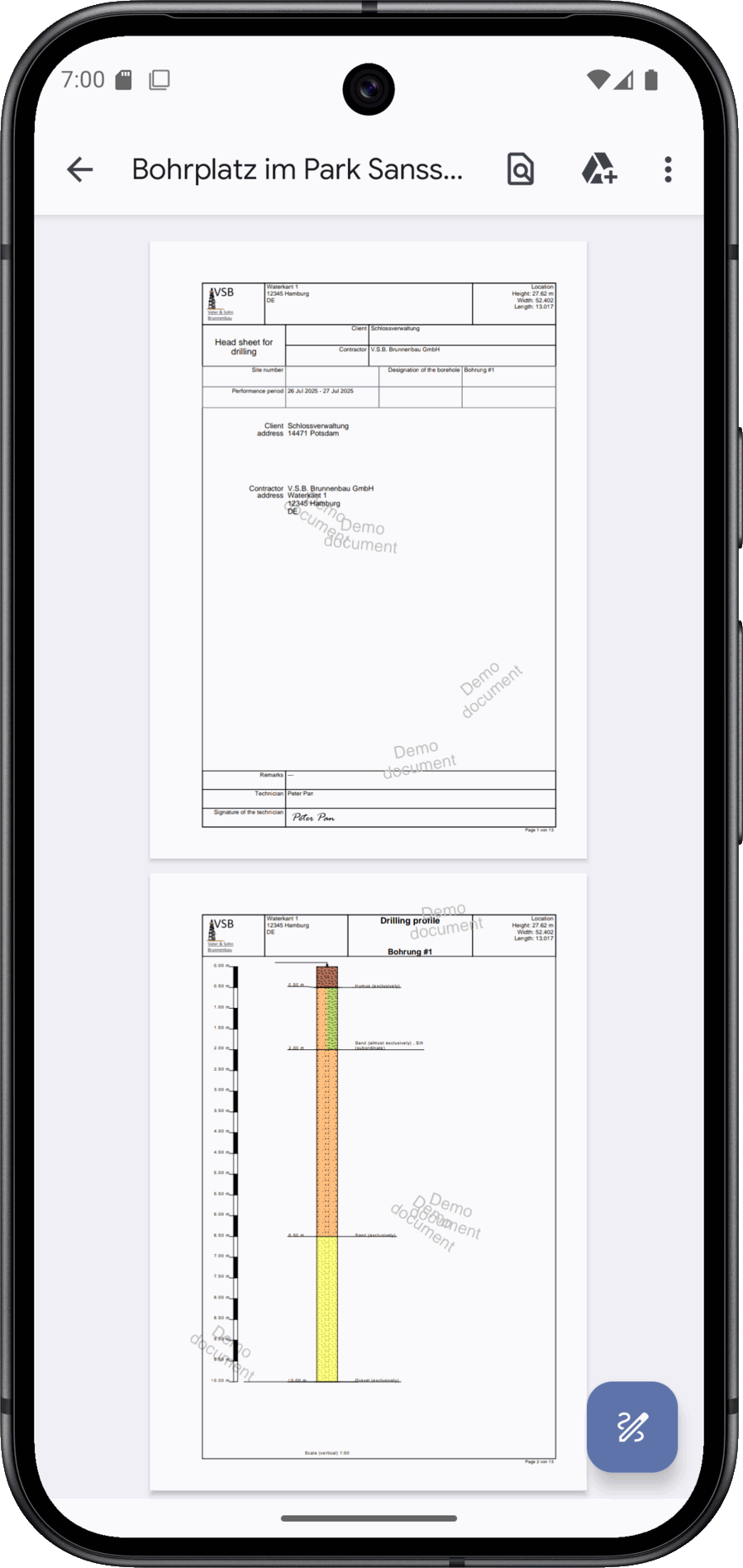
The documentation generated for the drilling site is transferred to your device as a PDF. You need a corresponding display programme to display the document.
You can currently use BoreDoc completely free of charge. Our current focus is on further developing the functions together with our users and optimising them for practical use. A binding pricing model will be introduced at a later date. Until then, you can benefit from all the advantages without restrictions and without hidden costs.

A stratigraphic log forms the basis of any systematic drilling documentation. It records which layers of the subsoil occur in which order and thus makes the geological structure comprehensible. With its help, the soil and rock conditions at a site can be objectively described and later retrieved. This ensures that the data collected is not only of value for the immediate purpose of the borehole, but also for future projects.
The list describes the layers encountered in their characteristic form. This includes information on appearance, texture and consistency, but also on special features such as odour, inclusions or differences in colour. Equally indispensable is the depth information, which defines the exact boundaries between the layers. This creates a continuous visualisation of the subsurface that remains comprehensible regardless of personal impressions.
There are many possible applications for the stratigraphic log. In civil engineering, it serves as a basis for assessing bearing capacity, groundwater conditions or possible subsidence. For environmental assessments, it provides information on the permeability and stratification of the soil, which can be decisive for the assessment of contaminated sites or groundwater movements. In geological research, on the other hand, it provides material for reconstructing historical deposits and developments.
A precise layer catalogue gives the drilling documentation its true significance. It provides a clear view of the subsurface, reduces uncertainties and creates confidence in further analyses. This makes it a key tool that plays a decisive role in the success of planning and projects.
Standards are essential to make a strata catalogue consistent and comparable. This includes DIN 4022,, which describes and standardises the approach to soils and rock. It is supplemented by DIN 4023, which is closely linked to the visualisation of layer sequences in the drilling profile. At an international level, ISO 14688 ensures standardised classification and terminology. Together, these standards create the basis for transparent, technically correct and supra-regionally comprehensible documentation of drilling results.
Download layer index sample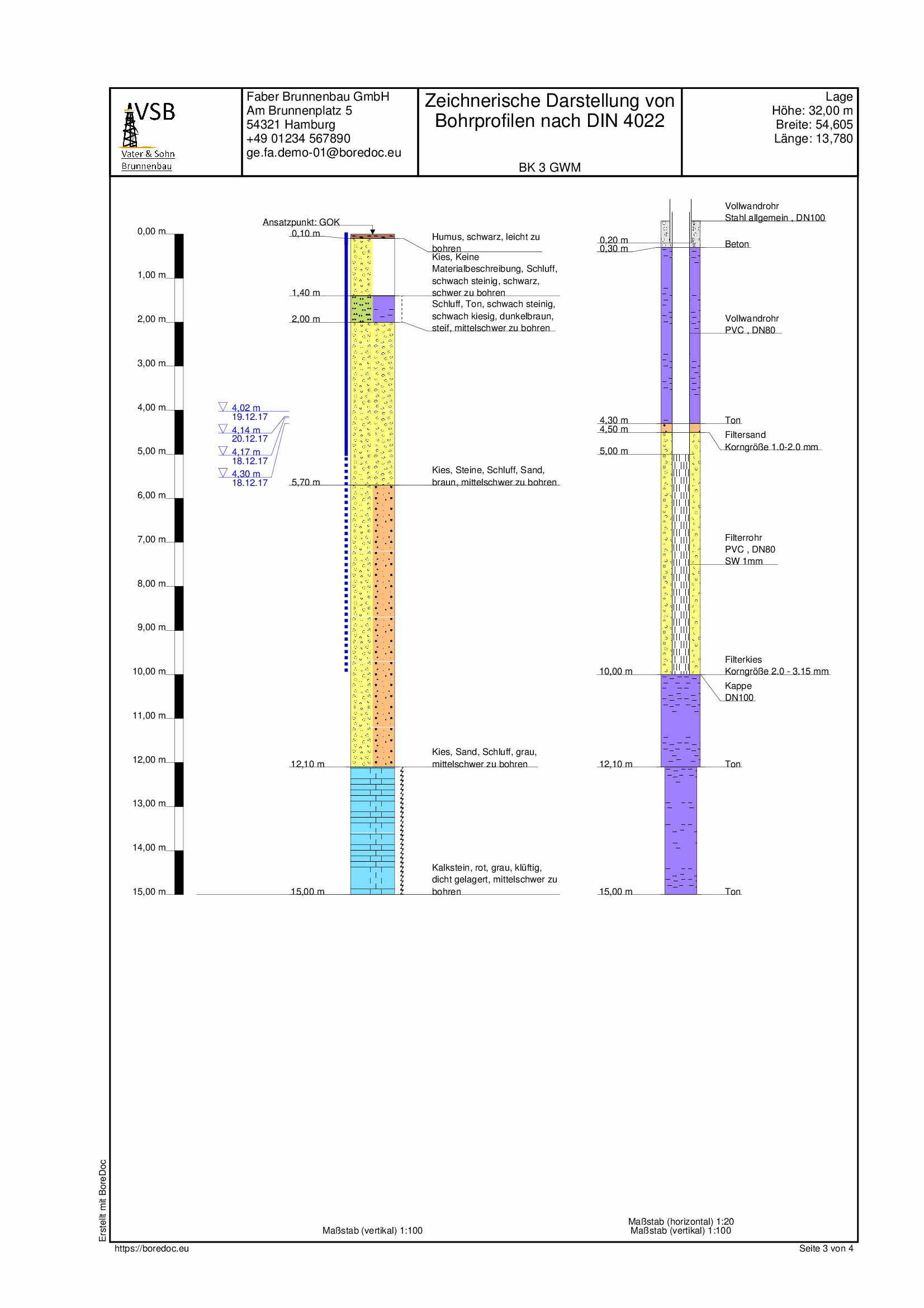
A borehole profile is the graphic realisation of the sequence of layers recorded during a borehole. It supplements the textual documentation with a clear visualisation that makes the subsurface visible in its vertical structure. This makes it possible to recognise at a glance which layers occur in which order, how thick they are and at what depth they lie. The aim is to make geological information clearly and directly accessible.
The representation is usually a vertical section in which each layer is clearly identified by symbols, hatching or colours. Depth information at the layer boundaries enables the exact location in the subsurface to be assigned. This creates a visual overview that allows quick orientation, independent of extensive texts. The drilling profile thus becomes an indispensable tool for geological documentation.
In practice, the drilling profile supports engineers, geologists and experts in evaluating the subsoil. It provides information on the load-bearing capacity, groundwater conditions or special risks and facilitates the selection of suitable construction methods. It is also an easy-to-understand basis for clients or authorities to make comprehensible decisions. It thus combines technical precision with a high degree of clarity.
The drilling profile also plays an important role in research. It allows conclusions to be drawn about the formation history of a region, documents geological processes and creates comparability between different locations. In environmental and hydrogeology in particular, it provides crucial information about the layer structure and possible water pathways. The drilling profile thus adds scientific value to its purely technical use.
The creation of drilling profiles is subject to established norms and standards in order to ensure uniformity and comparability. In particular, DIN 4023 (drilling profile), which regulates the graphical representation, and DIN 4022 (soil and rock characterisation) for the uniform description of layers. In addition, international standards such as ISO 14688 are used to name and classify soils. These standards ensure that drilling profiles can be understood in the same way regardless of location and time.
Download drilling profile sample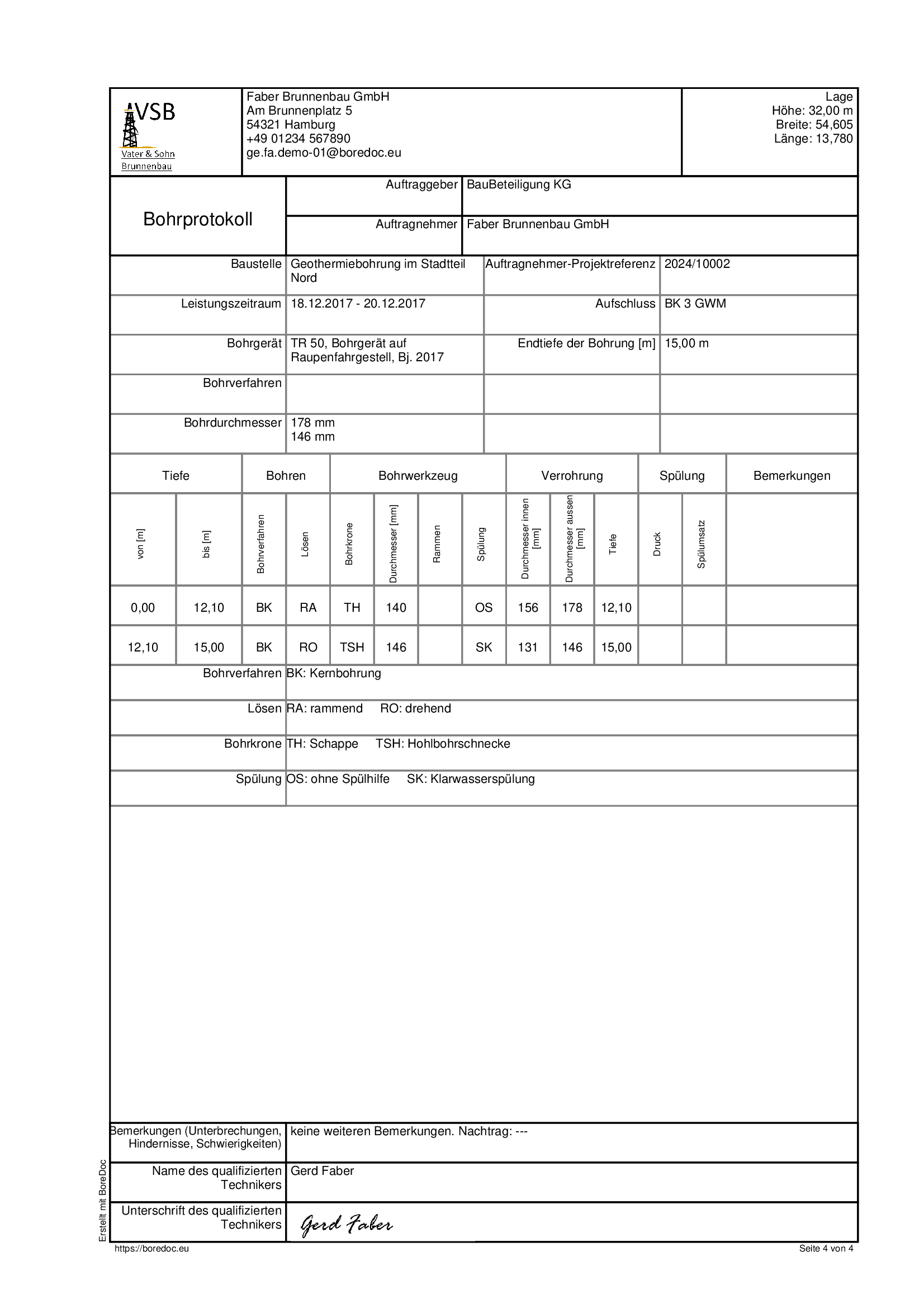
A drilling log is a technical document that records the entire drilling process in a comprehensible manner. It forms the basis for documenting geological observations as well as organisational and technical conditions. In this way, a complete picture of the drilling is created, which is indispensable for evaluation, planning and verification. The aim of the drilling log is to ensure transparency and traceability throughout the entire process.
The contents of a drilling log are wide-ranging. In addition to the equipment and methods used, the start and end of drilling and the depth reached are documented. The drilling progress, special technical features, flushing fluids or aids used and any faults that occur are also recorded. This comprehensive collection of information allows the working conditions and results to be reconstructed exactly.
In practice, the drilling log serves a variety of purposes. It provides an important basis for clients and engineers to make decisions about construction methods, safety measures and costs. At the same time, it serves as legal proof that the work has been carried out properly. Authorities can use the log to check compliance with regulations, while experts use it to back up their assessments.
In addition, the drilling log also provides valuable services in research. It not only documents the results, but also the circumstances under which they were obtained, which is crucial for the comparability and reproducibility of data. It therefore helps to make geological investigations permanently verifiable and scientifically usable. It unfolds its full value especially in combination with the stratigraphic log and drilling profile.
Standards are used to standardise the content and format of drilling logs. DIN 4021,, which regulates the documentation of drillings and the structure of the logs, should be emphasised. It is supplemented by DIN 4022, which specifies a systematic description of soil and rock types. ISO 22475, which defines standards for geotechnical exploration, sampling and groundwater measurements, is of international importance. These standards ensure that drilling logs remain standardised, comparable and technically reliable.
Download drilling protocol sample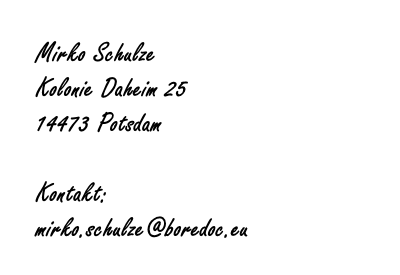
If you have any questions or suggestions regarding data protection, you are welcome to contact us via theContact formcontact us.
We take the protection of your personal data very seriously. Personal data is any data that can be used to identify you personally. This privacy policy informs you about what data we collect, how we use it and what rights you have - both when using the boredoc.eu website and when using our BoreDoc app.
When you access our website, your device automatically transmits data for technical reasons. The following data is stored separately from other data that you may transmit to us:
We store this data for the following purposes:
Your IP address is only stored for a period of 90 days.
In this case, the processing is based on our overriding legitimate interests mentioned above (Art. 6 para. 1 lit. f GDPR).
This website uses Google Analytics, a web analytics service provided by Google Ireland Ltd, Gordon House, Barrow Street, Dublin 4, Ireland.
Data collected: IP address (shortened), usage behaviour, device data
Purpose: Improvement of our offer
Legal basis: Art. 6 para. 1 lit. a GDPR (consent)
Data transfer: if necessary to third countries (e.g. USA) in accordance with EU standard contractual clauses
You can revoke your consent at any time or change it via our cookie banner.
Embedded videos from the YouTube platform (Google Ireland Ltd.) can be displayed on our website. Your IP address is transmitted to Google when loading.
Purpose: Provide multimedia content
Legal basis: Art. 6 para. 1 lit. a GDPR (consent)
Note: Depending on your cookie settings, a data connection may be established as soon as you access the page.
Our app uses Google Firebase for technical support and analysis. Firebase services used:
Processed data may include
Legal basis: Art. 6 para. 1 lit. a GDPR (consent at app start) Data processing in third countries: Google may use servers in the USA. Data is transferred in accordance with the EU's standard contractual clauses.
The BoreDoc app works offline for the most part. Only certain functions such as synchronisation, QR code sharing and creating documents use a server connection.
a) Local storage
The app saves your content (e.g. drilling data, user information) exclusively on your device, unless you explicitly activate a synchronisation or sharing function.
b) API key & e-mail
An API key is generated the first time it is used. The following data can be processed for synchronisation or team sharing:
Purpose: Access protection, collaboration, remote storage of documents
Legal basis: Art. 6 para. 1 lit. b and f GDPR
We may use external providers within the EU for hosting and API operation. These are contractually bound in accordance with Art. 28 GDPR.
Current processors:
All service providers are contractually bound in accordance with Art. 28 GDPR contractually bound.
Purpose: Access protection, collaboration, remote storage of documents
Legal basis: Art. 6 para. 1 lit. b and f GDPR
You have the right to:
Please submit enquiries via ourContact formto us.
We use the latest security measures:
We reserve the right to amend this privacy policy in order to adapt it to changed legal situations or technical developments.
The current version is available atData protectionretrievable.